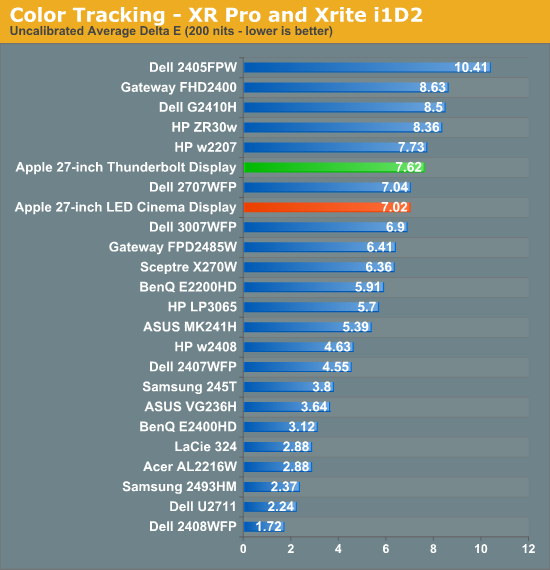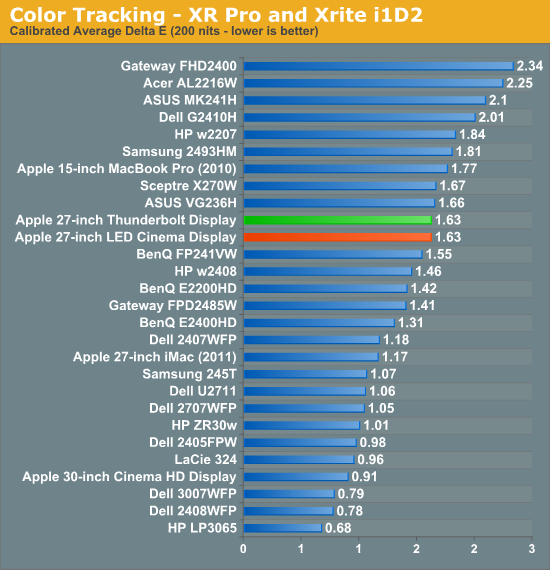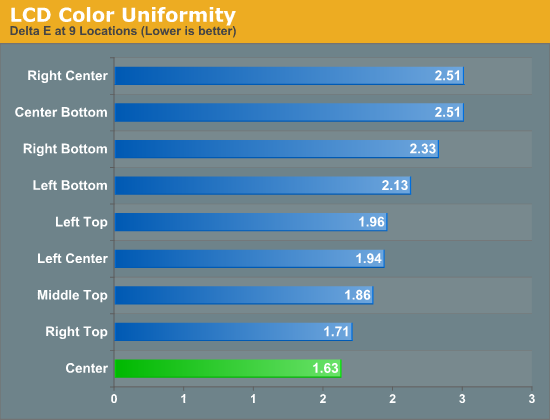The Apple Thunderbolt Display Review
by Anand Lal Shimpi on September 23, 2011 2:56 AM EST- Posted in
- Displays
- Mac
- Apple
- Thunderbolt
- Thunderbolt Display
Display Testing
With all of the extra connectivity there is to test with the Thunderbolt Display we can't forget the actual panel testing. Thankfully this part is pretty simple, the display characteristics are near identical to the 27-inch LED Cinema Display we reviewed last year.
Color Quality
We report two main quality metrics in our display reviews: color accuracy (Delta-E) and color gamut. Color gamut refers to the range of colors the display is able to represent with respect to some color space. In this case, our reference is the AdobeRGB 1998 color space, which is larger than the sRGB color space. So our percentages are reported with respect to this number, and larger is generally better.
Color accuracy (Delta E) refers to the display’s ability to display the correct color requested by the GPU and OS. The difference between the color represented by the display, and the color requested by the GPU is our Delta-E, and lower is better here. In practice, a Delta E under 1.0 is perfect - the chromatic sensitivity of the human eye is not great enough to distinguish a difference. Moving up, a Delta E of 2.0 or less is generally considered fit for use in a professional imaging environment - it isn’t perfect, but it’s hard to gauge the difference. Finally, Delta E of 4.0 and above is considered visible with the human eye. Of course, the big consideration here is frame of reference; unless you have another monitor or some print samples (color checker card) to compare your display with, you probably won’t notice. That is, until you print or view media on another monitor. Then the difference will no doubt be apparent.
As I mentioned in our earlier reviews, we’ve updated our display test bench. We’ve deprecated the Monaco Optix XR Pro colorimeter in favor of an Xrite i1D2 since there are no longer up-to-date drivers for modern platforms.
For these tests, we calibrate the display and try to obtain the best Delta-E we can get at 200 nits of brightness for normal use. We target 6500K and a gamma of 2.2, but sometimes the best performance lies at native temperature and another gamma, so we try to find what the absolute best performance could be. We also take an uncalibrated measurement to show performance out of the box using either the manufacturer supplied color profile, or a generic one with no LUT data. For all of these, dynamic contrast is disabled.

Uncalibrated performance remains fairly similar to last year's LED Cinema Display, however once calibrated the Thunderbolt Display is spot on with its predecessor:

As we mentioned earlier, a sub 2.0 delta E is good enough for professional use. Although not perfect the Thunderbolt Display falls within that range for sure.


We measured slightly lower color gamut on the Thunderbolt Display than the original LED Cinema Display, however the result was much closer to the 2011 27-inch iMac. I couldn't visibly tell any differences and Apple indicates that color gamut shouldn't have changed, so it's quite possible that the differences here are due to our colorimeter and not the panel.
Color Uniformity
Now for color consistency, we take our best calibration profile from the very center at 200 nits and test color accuracy at 9 different places around the LCD display in an evenly distributed grid. We’ve shown before that calibration is localized across the display, partly due to the brightness not being uniform, partly due to the discrete nature of the display itself.

The Thunderbolt Display was fairly uniform across its surface, something we noticed in reviewing the 27-inch LED Cinema Display last year. Uniformity is actually better on this panel than the one we reviewed last year, although in both cases I couldn't really tell any differences.
Peak brightness appears down slightly, but so are the black levels which result in a slightly better contrast ratio. Apple is also calibrating these things at the factory now so white points are now set at around 6300K vs. 7100K on the original 27-inch LED Cinema Display.










275 Comments
View All Comments
NCM - Friday, September 23, 2011 - link
At under a grand for a giant IPS display that incorporates at least $200 worth of extra connectivity (laptop power supply, T'bolt, additional ports, speakers) this monitor is good value for a MacBook Pro or Air user.Colour accuracy is more than adequate for most professional work. If it's not good enough you should be taking a big step up to something like an Eizo, both shrinking the display size and doubling the price in the process.
jecs - Friday, September 23, 2011 - link
You did read but you just don't understand what color accuracy means or what to do with it.What you call poor color accuracy is the gamut space that is important only if you work with wide gamut color. Apple does not cares for wide gamut, not with this display or with past displays. It does not means the display is not accurate in color, it is very accurate. But Apple optimize their displays for print accuracy were wide gamut is not required. Even for FCP Apple doesn't work with wide gamut. For consumer use wide gamut is also a mixed bag because many complain the color in general looks to bright or "artificial".
I have a 2410 Dell display because I care for wide gamut for what I do but I do appreciate Apple displays and this thunderbolt display is good and other vendors should pay attention to the connectivity and function for desktop use. I would want a mate screen version for more serious professional design but for demanding consumers who appreciate quality and efficiency this is a nice option.
But right now what you need to know is what display is best for what you do.
Are you a professional. Are you a consumer or an aficionado looking for an intermediate option. Or buying the cheapest display.
The Apple displays are for entry level professionals or high end consumers or hobbyist.
For broadcast professional work or for cheap options look else where.
hechacker1 - Friday, September 23, 2011 - link
While I agree with your overall point, I don't think the calibration used by Anand is really informative unless you are doing photo processing work.He's targeting the Adobe 1998 profile, which is great for photo editing and printers that support that target (rare unless in a professional setting).
Most of the Internet is SRGB profile by default, and I'm guessing this display would perform even better there. Most consumer cameras also target SRGB unless you are talking about RAW mode prosumer cameras.
The fact that this display can accurately display most of the Adobe profile bodes well for its accuracy.
If you were in Broadcasting or video editing, you should target Rec. 709 profile, which has completely different gamma curves.
In my opinion, Apple displays are generally very good for the money. Even my late 2009 Macbook Pro can calibrate to excellent color accuracy with VERY little error.
However, my biggest complaint is that lately Apple displays target 6800-6900K color temps, which are too blue for most calibrations and profiles. Sure it looks good to the untrained eye, but it's bad for color accuracy.
jecs - Friday, September 23, 2011 - link
I agree to your more expert opinion than mine.Apple is moving more than ever to the high end consumer or prosumer and the move to the higher kelvin could be another sign. Final Cut X and the price is another example.
But all in all Apple displays are still good monitors.
If you want a very cheap desktop IPS panel Dell also has a new Ultrasharp line with a shorter gamma space and fewer connectors. But there are other cheap options.
Ratman6161 - Friday, September 23, 2011 - link
...that I would not be in the market for a $1000+ display from Apple, Dell or an other manufacturer. What i'm in the market for is the best I can get for $200 - $300. Now, what I can get for my dell is a docking station that comes with an additional power brick for $129.00. So I can get a decent (not great but decent) 22 to 24 inch display + a docking station well within my budget.I guess if a 27" is what you absolutely have to have and you are willing to pay for it, this is a good option...but not for me.
NCM - Friday, September 23, 2011 - link
Which is fine and all, but the fact that you aren't in the market for a monitor in this category is completely irrelevant to the discussion.What's next, that we start posting about our cats?
BrooksT - Saturday, September 24, 2011 - link
Why would you spend $200 on a monitor when you can get a legal pad and pen for $8? I guess if you have to have a computer monitor and you're willing to pay for it, but paper and pen are better options for many people.name99 - Friday, September 23, 2011 - link
Professionals pay for quality tools.Look, if you're earning $100K a year, and this makes you more productive (not to mention happier) it's worth it.
Are you amazed that professional carpenters don't use $5 saws from Target? That professional truckers rig up the insides of their rigs with fancy electronics? That professional musicians buy high quality instruments, not what they can find on Craigslist?
seapeople - Friday, September 23, 2011 - link
You can also buy a $60,000 Cadillac Escalade SUV to pick up your kids at soccer practice.What's your point again?
alphaod - Friday, September 23, 2011 - link
Nice review as usual; very tempted to purchase one, but I think I'm fine with my current setup; already have a power supply I keep plugged in at times.Honestly if Apple added a powerful GPU, yes I think it would a more enticing purchase, but than they'd have the issue of cooling this unit, powering this unit, and constantly upgrade GPUs; at the same time, we'd have people posting online asking all day when the next Thunderbolt GPU updates will come. This would probably also cause problems with pricing; it would come awfully close to the price of an iMac which I'm sure most people would then consider buying an iMac instead (making this product redundant).
Personally I'd prefer if Apple added an optical drive (for those of us who replaced the optical drives in our MacBook Pro notebooks), optical out, better GPU in the display~Hell forget about releasing this display; redo the iMac as a dock for the MacBook Air/Pro!